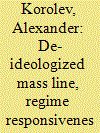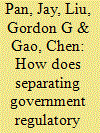| Srl | Item |
| 1 |
ID:
153566


|
|
|
|
|
| Summary/Abstract |
Once the primary method of revolutionary leadership, the “mass line”
has reemerged in today’s China as a method of public policy making.
Th is study explores and theorizes the implications of mass-line tactics
in policy making and state-society relations in contemporary China. At
the theoretical level, it argues that the de-ideologized mass line in
combination with traditional forms of nonmobilized participation can
enhance government responsiveness to the broader public interest. Th e
mass line can complement traditional forms of voluntary participation
in that it can allow better representation of social groups who regularly
fail to articulate their needs through the existing participation mechanisms
and who therefore remain outside of the policy-making process.
Empirically, the paper draws on existing Chinese studies, official
document analysis, and unstructured interviews with Chinese
academics to provide examples for the theoretical argument. Th is study
analyzes the workings of the mass-line tactics in China during the New
Healthcare Reform and the formation of the 12th Five-Year Plan. If
implemented not as a propaganda tool but as a mechanism of interest
articulation and aggregation, the mass line has the potential to off er
China alternative routes of democratization.
|
|
|
|
|
|
|
|
|
|
|
|
|
|
|
|
| 2 |
ID:
124540


|
|
|
|
|
| Publication |
2013.
|
| Summary/Abstract |
This paper evaluates the effect of regulatory reform separating the operational control and regulatory oversight of public hospitals in China. Using city-level data and a difference-in-difference (DID) model, this paper estimates the changes in healthcare supply in response to the regulatory reform. Based on the DID estimates, in Weifang between 2006 and 2008, the reform led to a 39.3% increase in the number of doctors per 10,000 residents and 40.1% increase in the number of health workers per 10,000 residents. Similarly, in Suzhou between 2005 and 2008 the reform led to increases of 60.5%, 30.8% and 36.6% for hospital beds, doctors and health workers per 10,000 people, respectively. Moreover, the magnitude of this impact appears to increase over time. Furthermore, the effect of the reform is consistent regardless of whether the separation reform takes place inside or outside the government. These findings lead us to conclude that the government should focus only on the regulation of healthcare markets, while leaving hospital operation to the free market.
|
|
|
|
|
|
|
|
|
|
|
|
|
|
|
|